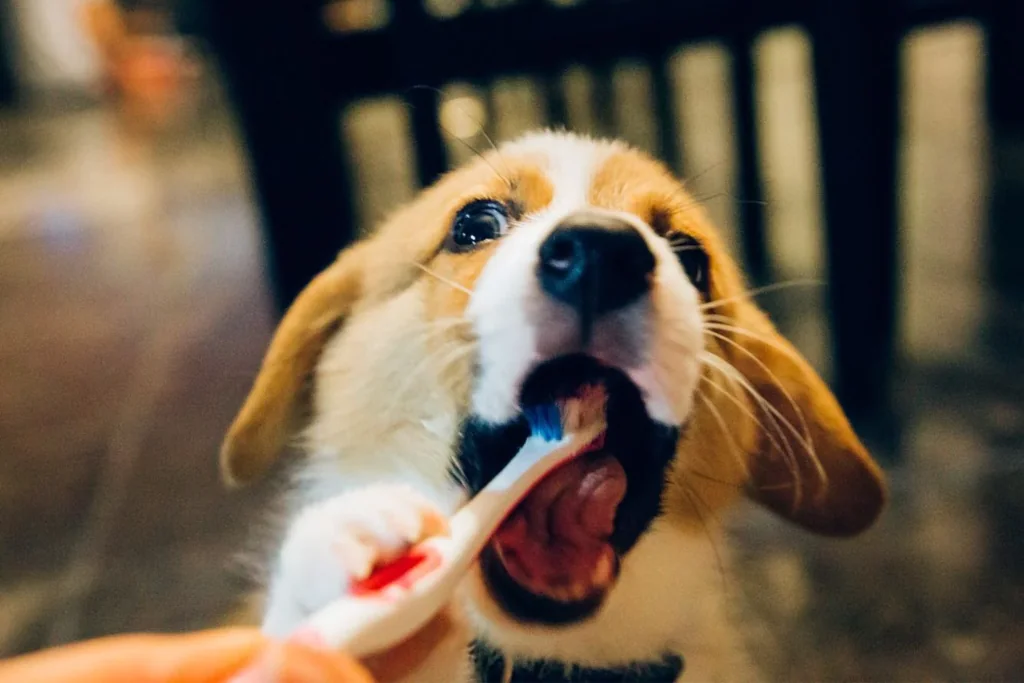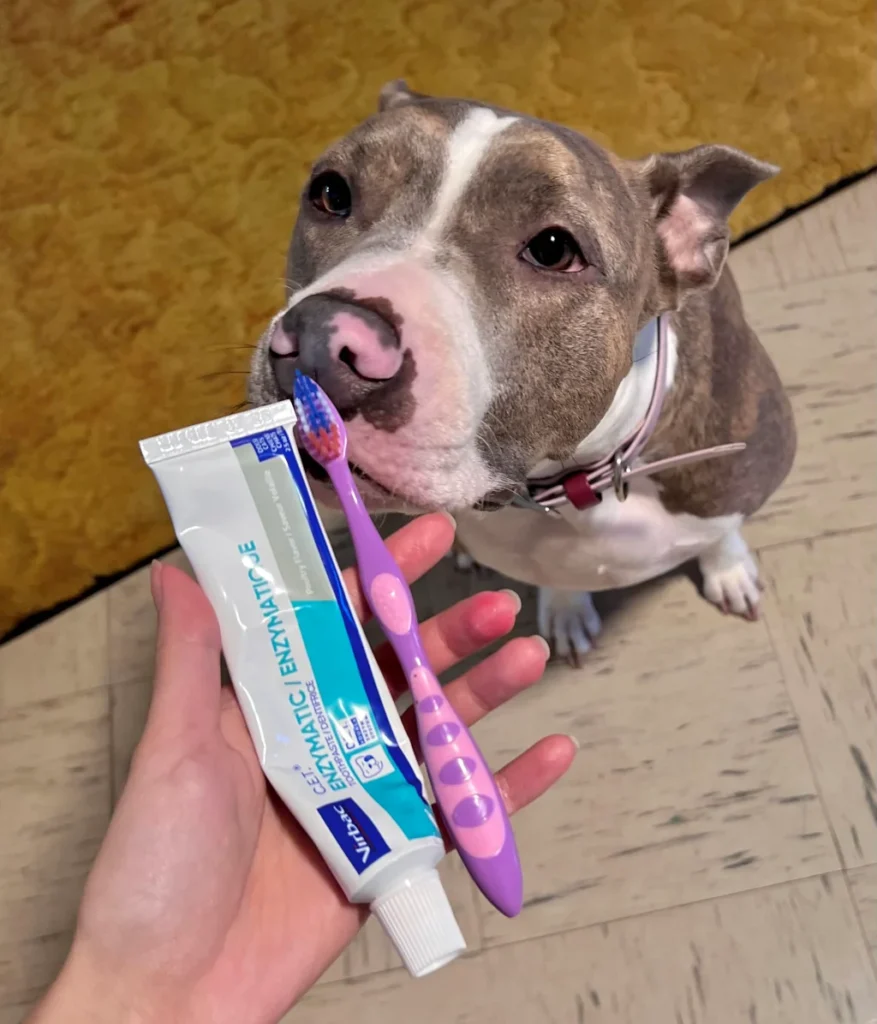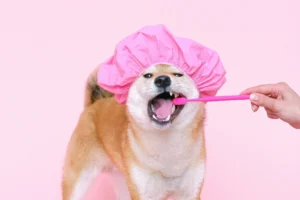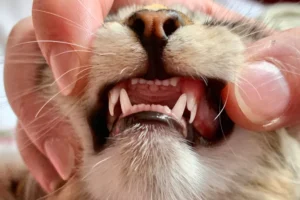Disclosure: We may earn a commission from helpful, relevant links in our content. No cost to you. See our privacy policy.
Paws up if you’re feeling overwhelmed by the mere thought of brushing your dog’s teeth. You’re not alone!
So many of us fret about causing discomfort to our beloved pooch, or just wonder if it’s really necessary. Isn’t the natural action of chewing enough to keep their teeth clean?
Then there’s the wrangling involved – turning a simple brushing session into a battle of wills. But don’t toss the toothbrush just yet, we’re here to dispel some myths, offer solutions, and show you why and how to transform dental care into a fuss-free, even fun, routine for your furry friend.
After all, who wouldn’t want their dog to flash a set of pearly whites and have a fresh breath?

Why Brush Your Dog’s Teeth?
Dental health is not just about a winning smile and fresh kisses. It plays a crucial role in your dog’s overall wellbeing.
Just like in humans, poor oral hygiene in dogs can lead to plaque build-up, gum disease, tooth loss, and even systemic infections. Besides, let’s face it, dog breath can be rather challenging to deal with, especially when your pup is a fan of close-up cuddles.
Regular brushing not only contributes to fresher breath but also prevents health complications, reducing costly vet bills down the line.
So, for the sake of those loving cuddles and your dog’s long-term health, picking up that toothbrush is definitely worth it.
When to Start Brushing Your Dog’s Teeth
It’s ideal to start when your pup is still a youngling, around 8 to 12 weeks old. At this age, they’re more open to new experiences, and it’s easier to form a habit.
Don’t worry if you’ve adopted an older dog, because it’s never too late to start. Patience and gradual introduction are key. First, let your dog explore the toothbrush and toothpaste, then gradually work your way up to a full brushing session.
Remember, the aim here is to make teeth brushing a positive, stress-free experience for both you and your dog.
Choosing the Right Toothbrush
Just as dogs come in all shapes and sizes, so do toothbrushes. Picking the right one can make your brushing routine easier and more effective.
As an experienced dog owner, I can vouch for the effectiveness of trying out different styles until you find one that fits your dog’s comfort and your ease of use.
Small dogs or puppies often do well with finger toothbrushes that slip onto your fingertip, offering more control and fostering a gentle, reassuring touch that can help to ease initial brushing anxiety.
For larger dogs, consider a dual-headed toothbrush with bristles at different angles. It’ll help reach those hard-to-get areas.
A game changer for those dogs that are a bit fidgety is a three-sided brush. This type of brush brushes multiple surfaces at once and is a true lifesaver, turning a fussy brushing session into a seamless, quick routine.
Lastly, the hardness of the bristles is crucial. Always opt for soft to medium bristles to avoid any gum irritation.
Suggested read: Choosing the Right Dog Toothbrush
Picking a Dog-Friendly Toothpaste
Now, let’s talk about the substance that’ll do the actual cleaning.
It’s critical to use a dog-specific toothpaste. Human toothpaste often contains fluoride and xylitol, both toxic to dogs. Dog-friendly toothpastes are not only safe but come in flavors like chicken or beef, making the brushing experience more palatable.
Some toothpastes even offer benefits like tartar control or gum disease prevention. Personally, I’ve seen great results with enzymatic toothpastes. They contain enzymes that break down plaque biofilm, reducing the need for vigorous brushing.
But, remember, each dog is unique. You might need to try a couple of options before you find your pooch’s preferred paste.
Suggested read: Choosing Dog Toothpaste
Stick with it, and the results will show in a healthier mouth and fresher breath for your best friend.

First Brushing – What to Expect?
The first tooth-brushing experience might be a little strange for both of you, and that’s okay. Your dog might resist or wiggle a lot.
This is where Sam, my older dog, surprised me. He was curious about the toothpaste flavor and enjoyed the extra attention. But it might not be the same for every dog. Patience and a calm demeanor are your best tools.
Make this a positive experience for your dog, praise them frequently, and use treats to reinforce good behavior. And remember, it’s okay if you only manage to brush a few teeth on the first try. Success here is measured in small steps.
How to Brush Your Dog’s Teeth (Step-by-Step)
Brushing your dog’s teeth doesn’t need to be a chore. Here’s a step-by-step guide to make it a smooth process:
- Get Them Comfortable. Begin by touching your dog’s mouth and teeth lightly without the brush. This gets them used to the feeling and reduces nervousness. A little peanut butter on your finger can be a useful distraction.
- Toothbrush Introduction. Let your dog sniff and explore the toothbrush before starting. Try dipping it in something they like, such as broth or dog-safe peanut butter.
- Start Small. Brush one or two teeth at first and gradually increase the number each day.
- Brush Gently. Brush in soft circles, focusing on the gum line. Don’t forget the back teeth, as they often accumulate the most tartar.
- Praise and Reward. Always end with a reward to make this a positive experience. A small dog-safe treat or extra cuddles will do the trick.
- Regular Maintenance. Brush your dog’s teeth daily if possible, but at least a few times a week. Regular brushing will lead to healthier teeth and fresher breath.
Now, here’s a unique tip most sources don’t mention: make tooth brushing a scheduled event. Dogs love routines, and if brushing their teeth becomes a part of their daily activities, they’ll likely be more accepting of it. You could incorporate it post-walk or pre-bedtime.
Trust me, it works wonders! I started brushing Charlie’s teeth after his evening walk, and within a week, he would sit by the sink, waiting for his brushing session. It was a game-changer.
How Often Should You Brush Your Dog’s Teeth?
Vets recommend brushing your dog’s teeth daily. This frequency helps to prevent plaque buildup and gum disease, much like in humans. However, if daily brushing isn’t feasible, aim for at least three times a week.
How to Make Brushing a Fun Routine?
To make tooth brushing enjoyable for your dog, associate it with something they love.
This could be a special toothpaste flavor or a post-brushing treat. Using a reward system and positive reinforcement can turn a dreaded task into a fun routine.
Try pairing the brushing with a game of fetch or a belly rub. One unique suggestion: use a soft, soothing voice to “narrate” what you’re doing, just like a story. Dogs love hearing their human’s voice, and this can help keep them calm and engaged.
What if Your Dog Absolutely Refuses?
If your dog absolutely refuses to have their teeth brushed, don’t force it. Instead, consider alternative dental care options such as dental chews, dental toys, or water additives.
For a professional touch, periodic cleanings by a veterinarian can also help maintain your dog’s dental health. As someone who’s experienced this with my own dog, patience, persistence, and positive reinforcement are key.
Brushing your dog’s teeth can be easy. And sometimes, your dog will help you with the brushing, take a look:
FAQs
Can I use human toothpaste to brush my dog’s teeth?
Human toothpaste often contains ingredients that can be harmful to dogs, such as xylitol and fluoride. Therefore, always opt for a dog-friendly toothpaste.
What are the signs of dental problems in dogs?
Indicators of dental issues in dogs can include bad breath, difficulty eating, red or bleeding gums, and loose or missing teeth. If you notice these signs, it’s time to consult with a veterinarian.
Are there specific breeds that need more frequent teeth brushing?
Breeds with a predisposition to dental issues, such as small breeds or brachycephalic breeds (like Bulldogs or Pugs), may benefit from more frequent brushing. However, all dogs will benefit from regular dental care.
Should I also floss my dog’s teeth?
While traditional flossing can be beneficial, it’s often challenging and potentially stressful for dogs. A thorough brushing routine and professional cleanings can generally maintain a dog’s oral health without the need for flossing. You should, however, consider dental chews as a form of flossing.
Alex, a passionate animal lover, has experience in training and understanding animal behavior. As a proud pet parent to two dogs and three cats, he founded AnimalReport.net to share insights from animal experts and expand his knowledge of the animal kingdom.




